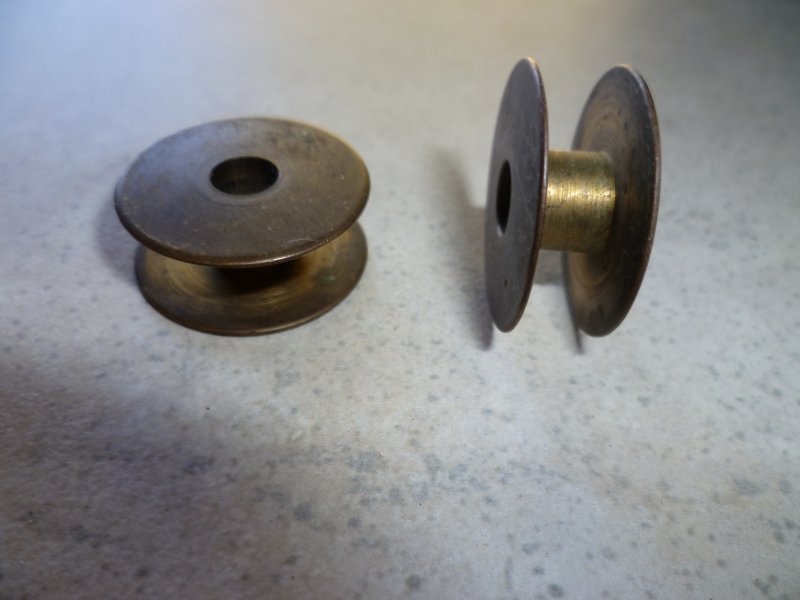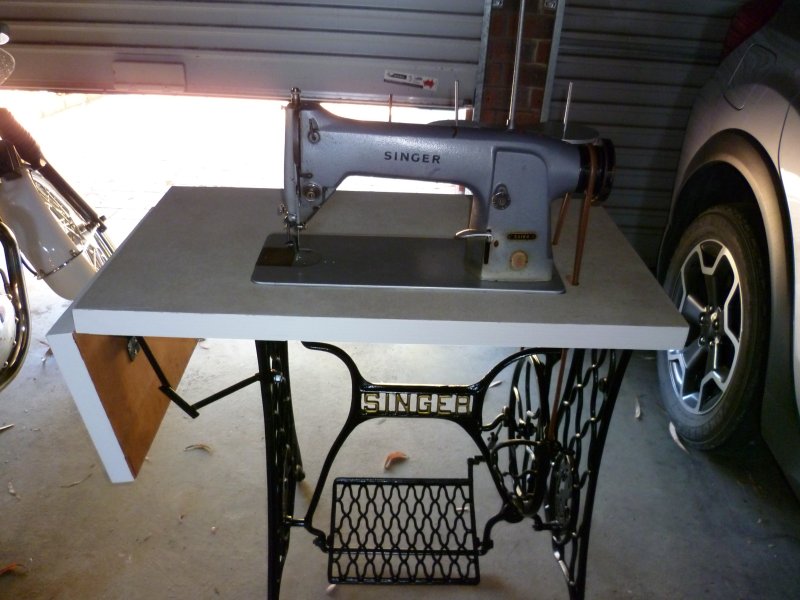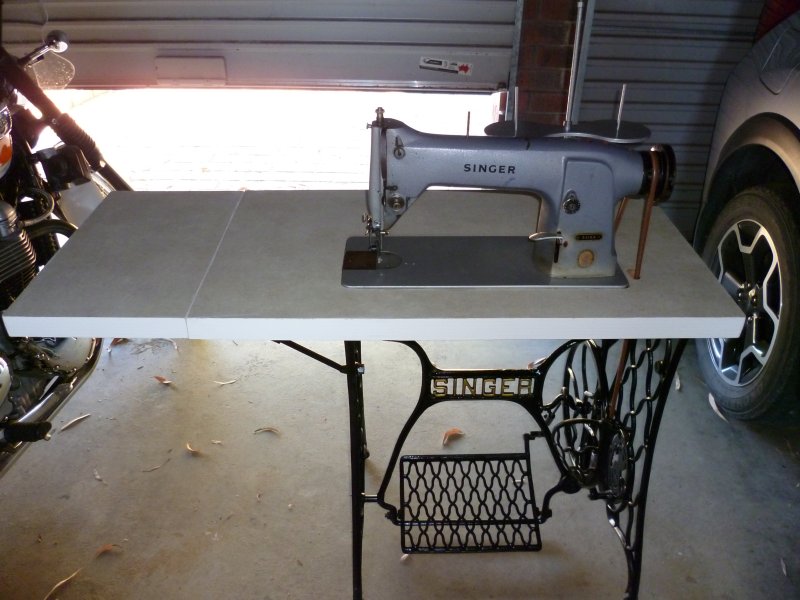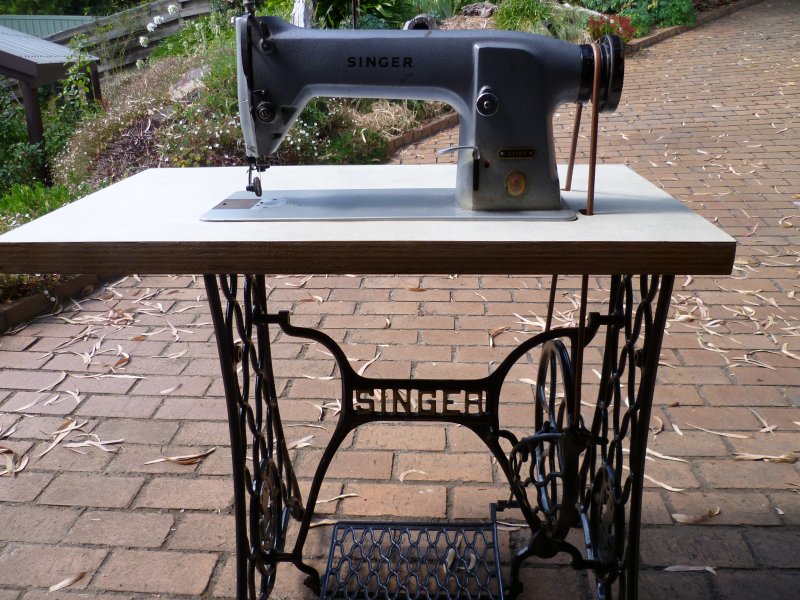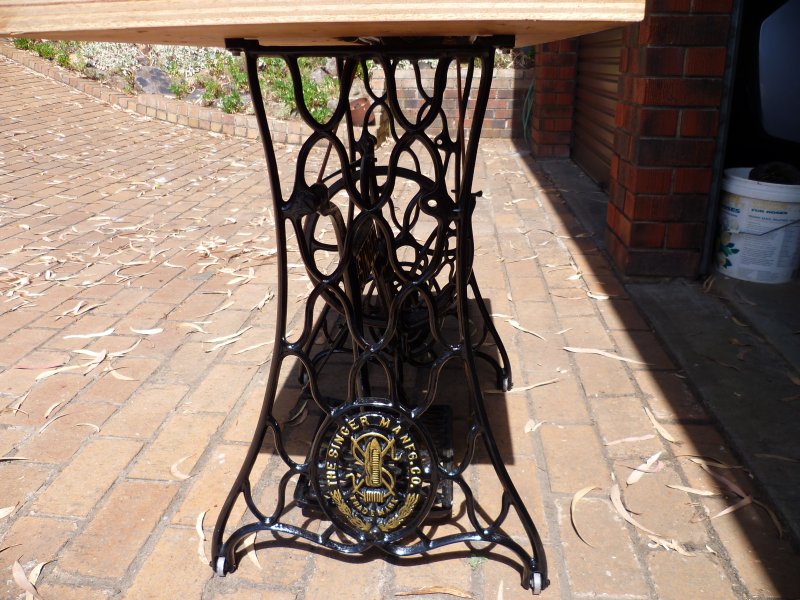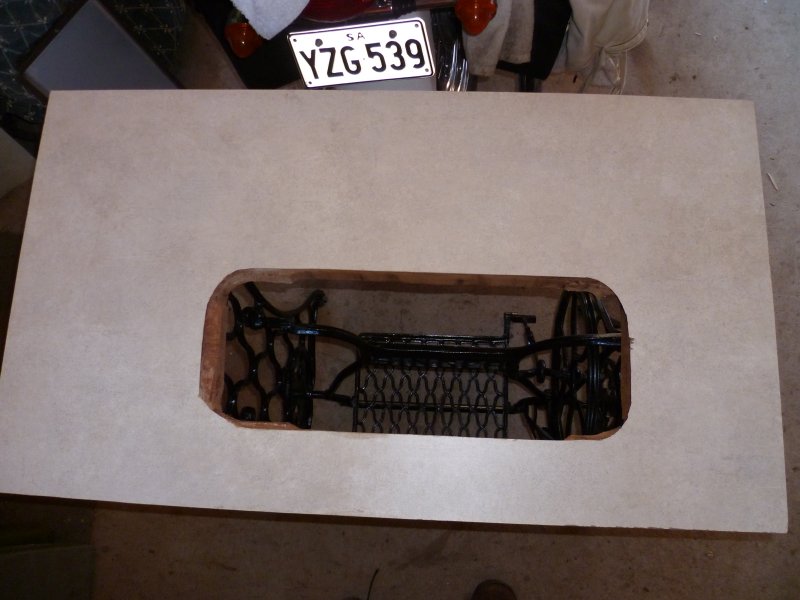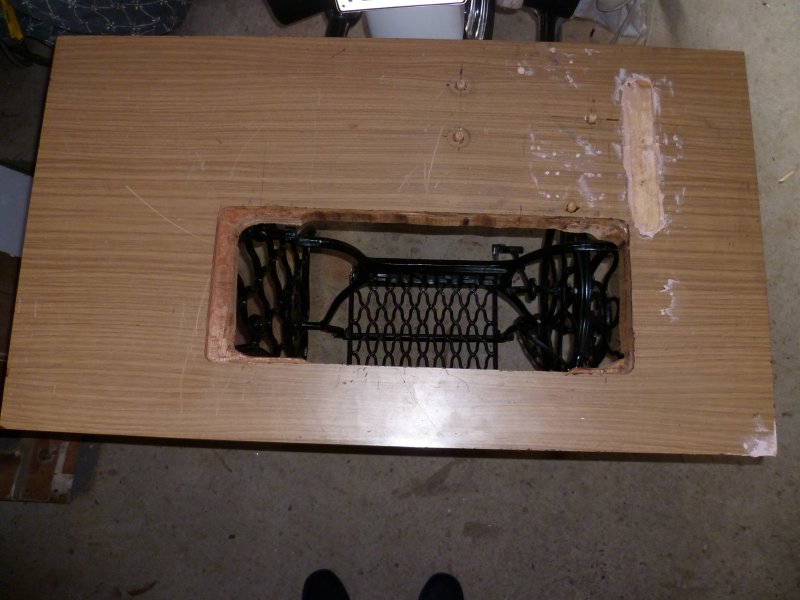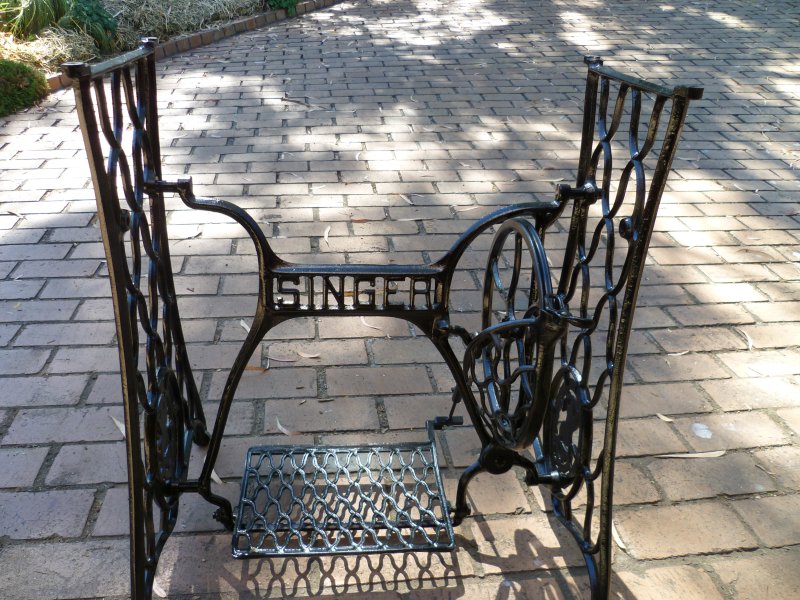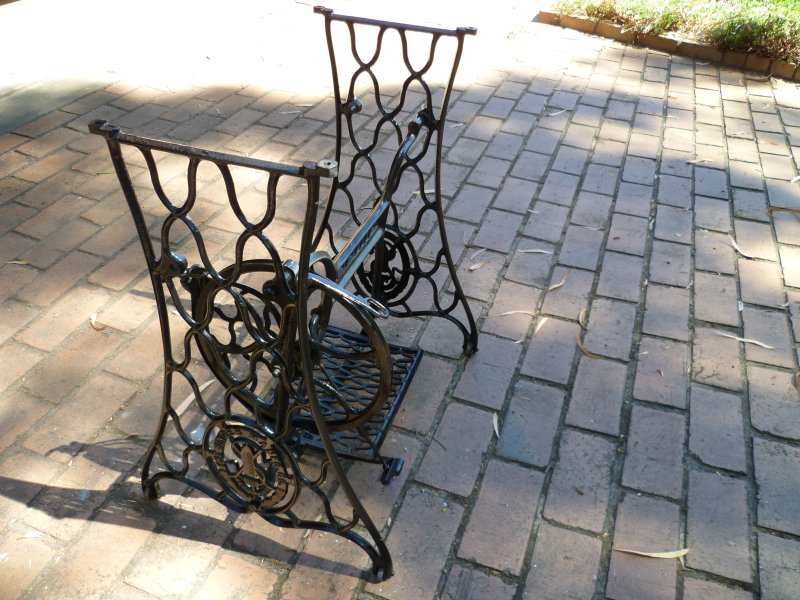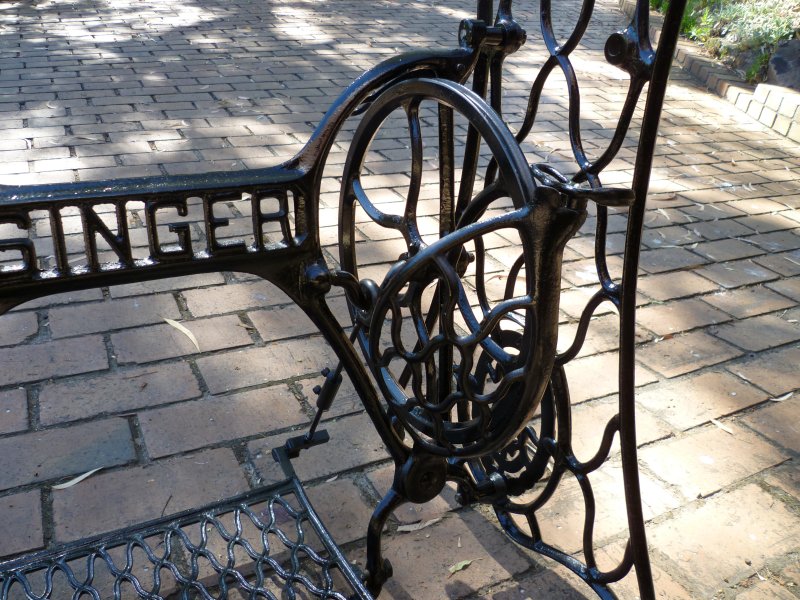-
Posts
4,808 -
Joined
-
Last visited
Content Type
Profiles
Forums
Events
Blogs
Gallery
Everything posted by dikman
-
Now that is nice! I haven't seen a post bed walking foot before. Other than the paint being worn off the baseplate it looks to be in very good condition. I've given up using my Singer post bed (roller wheel) because it's too easy to deflect the needles and break them! A walking foot, however, would be real nice to have...
-
Suzelle, that one has reverse on it. The machine was free (!), someone was giving it away, it cost me $25 for a replacement shuttle race (very worn), a can of paint for the baseplate and about $17, I think, for the roller wheel. Haven't sewn much with it yet, I only got it 'cos it was free .
-
Buried somewhere in that vast warehouse, maybe?
-

Commercial Singer Treadle (motorized) w/96-10 Head
dikman replied to suzelle's topic in Leather Sewing Machines
Nice one, Suzelle, at that price I would have grabbed it just for the base! I'm getting a bit scared because I'm starting to look at treadle bases but I've run out of room!! -
-
Yep, fit a speed reducer, depending on the size of the pulleys it will give you much slower speed and increased torque. Plus fit the smallest pulley you can to the motor, it will all help.
-
Good point in removing the belt. Then start/stop the motor a few times and see which way it turns - always the same way or is it inconsistent?
-
Having finished off the treadle, I had a quick look at the machine itself and noticed there is a lot of backwards/forwards free play when turning the handwheel, so I suspect it may be pretty worn somewhere. I think I'll put this aside for a while as it's not something I need. One interesting (to me) thing I found in the bits that came with it is a heap of bobbins, all made of brass! They measure 15/16" diameter x 0.37" wide and unfortunately don't match any other machine that I have - but they do look nice.
-
This is pretty well the finished product (other than making the bearers to fit under the little wheels, may take some time). Now I just have to learn to treadle!!
-
Hi CSM, as Uwe said an AC (Alternating Current which is what normal mains power is) electric motor can be difficult to start spinning without help (and can start in either direction). The usual way to do this is with a separate start winding or a capacitor (electrical component) which assists it to start (and in the right direction). My old Singer motor, which is at least as old as yours, has a large switch box with a capacitor inside, and while it still works I won't use it. Modern motors often have the capacitor mounted in the base or in a housing attached to the motor. I recently had a problem with a belt grinder, it was slow starting and I needed to spin it by hand to help it get up to speed. I replaced the capacitor and all was well. In your case, however, I agree with Uwe in that I wouldn't mess around with a motor that old (unless you know exactly what you're doing). Replace it with a servo, it will make sewing so much easier. I recently bought an old Singer that had an equally old original Singer motor. I took one look at it and junked it, I didn't even try it to see if it would work! It's one thing to restore an old sewing machine, it's another to mess around with old, and potentially lethal, motors. I hope this helps you? (I do have a tendency to waffle a bit).
-
Thanks CD. One problem I have is that the handwheel is too small. None of my other handwheels will fit, as they have a 1/2" bore and the shaft on this machine is actually slightly larger than 1/2". I have a few options - bore out one of the handwheels to fit this shaft (but then it wouldn't fit anything else), find a suitable steel disc and turn a handwheel to bolt onto the existing wheel, likewise with a piece of aluminium, cast an aluminium handwheel or turn one from wood and bolt it to the pulley. I'm going to have to give this some thought. I've also come to the conclusion that this setup will only be suitable for cloth and/or light garment leather - no big deal really. (I just saw an old White treadle machine for sale for $100. It has a bigger drive wheel and would be nice to play with, but I'm not game to say anything to my wife!!!).
-
Good point, Bob. Someone on here some time ago had a similar problem, turned out to be a dried out capacitor in the start cct. (not uncommon in old motors).
-
Interesting link, Lee, that guy's pretty serious! Anyhow, nearly finished - I think. Works much easier with the 331K4. One minor drawback with this setup is that the needle is almost in line with the left hand leg, so I tend to sit a bit funny at the table. I'm also thinking that a larger handwheel (and pulley) might make it easier to use. Have to fit the drip tray, paint the edges of the table and fit the drop-down part on the left side of the table (not really necessary but it was already fitted to the original table). And a spool holder. And a light of some sort. I've decided I don't like the little steel wheels on it, everything shakes and vibrates when I move it!! I'm thinking of a couple of wooden bearers under the feet with some casters/wheels, but I'm going to have to off-set the casters otherwise it will raise it too much (I think Uwe did something similar).
-
Not finished yet but I put the 166 on it to try it out. Two things quickly became apparent - I need a lot of practice to get the hang of treadling, and the heavy mechanicals in the 166 might be too much for the treadle (at least until I become much more proficient!). I think I'll put the 331K4 straight stitcher on it for now.
-
Nice! Mine has a single pedal but yep, I don't know where I can use it but I'll definitely clean it up and might even just put a nice table top on it. Whatever happens I'm not getting rid of it!!
-
I doubt it is a Singer mod, it looks a little homemade (even though it's a pretty good job). It's just a really bizarre setup. Anyhow, my replacement tension assembly arrived today from Kunpeng. Very quick service and just bolts straight on.
-
Excellent, Constabulary, I've added it to the growing list of documents that I have. The pictures explain a couple of things about mine, in particular that the thread tension parts are definitely non-standard. I also note that mine should have 1/2" clearance under the feet, so it would appear to have been re-adjusted 'cos it definitely hasn't got that much clearance.
-
After measuring things, I realised that only the left hand leg would have to be moved and would require nearly 3" spacers! I didn't feel comfortable with that, so decided to leave it as is which would give me a choice of five machines which would fit the table. A relative gave me some assorted laminate pieces some time ago, so I dug them out and found a nice imitation granite - unfortunately it must have been very old as everything I tried to cut it with caused cracks/splits/edge chips.There was another piece which seemed to cut ok so I used that. In the photo it looks pinkish, but that's the camera, it's actually an off-white with faint darker random patterning and doesn't look too bad. I have to get a guided router/laminate bit tomorrow, however, as I don't have anything that will let me cut out the curved bits for the machine cutout (it keeps chipping!!). I'll also get the gold paint and some synthetic "belt" to replace the leather stuff. Trickiest part will be locating where to cut the holes in the table for the belt.
-
cd, I'm not too worried about the weld, BUT I have been wondering if the 166 might be a bit much for the treadle, given the driving wheel is only 12". You have more experience with this sort of thing than me, and my gut feeling now is that yeah, it may not be the best choice. That was why I wanted to fit the 117 as it's a lighter duty walking foot. Thinking about it, if I make new spacers to shift the two upright legs away from the centre section (that holds all the working bits of the treadle) I can widen it enough to fit the longer base of the 117. I'll have to use nuts and bolts through the spacers, as the original bolts will be too short, but that could work, as I only need a bit under 1'' more each side. More measuring required - and lathework. Anyhow, this is the table top I've got to work with, there's a hinge piece that fits on the left to give more workspace.
-
It's looking a lot better than the yucky grey that it was painted when I bought it! Still have to get some gold paint for the lettering (local hardware store didn't have any so I'll have to go farther afield). I know it's not necessary picking out the name in gold, but it just seems the right thing to do. I made a replacement pivot screw for the main wheel axle and re-welded the broken stub onto the footplate. After much tossing around of ideas, I machined a sleeve to fit the stub and welded a square bar to it. The pitman rod has a ball joint at the end and there was no obvious (read:easy) way to adapt it to the square bar so I cut the rod halfway, made a connecting sleeve and made a new lower section with a thread on it, this gives me plenty of adjustment if needed. Bolted it all together and it works great!!! I just have to machine a replacement screw for the front belt guide sometime, as this had been snapped off. Next thing is a table. I have an old one off another machine, but it has lots of holes and a large belt slot. I'll thinking I'll fill in the belt slot and holes, and then glue a new piece of laminate on top to cover it all. My original intention was to fit the 111W117 that I just bought, but that has a longer base than my other machines so won't fit this treadle assemble without a lot of messing around. The other Singers all have the more normal base size so will be a drop-in fit on the table. As to which machine, I first thought the straight stitch 331K4, but then thought of the 211G166 - I think a walking foot would be nice on it. I had intended to re-fit the clutch/pulley arrangement that came with it, but after thinking about it I can't see any point, I reckon I'll just keep it simple.
-
Whatever it is it looks to be in very good condition. On the upper right of the body are two holes, maybe where the label was (or is supposed to go?).
-
At $50 that's a steal, and if he's prepared to drop it further.......I wouldn't hesitate for 1 second if someone offered me that!
-

PFAFF1445 Need some help judgeing stitching
dikman replied to chasman52's topic in Leather Sewing Machines
chasman, I was like you when I started, I didn't want to spend the money on a servo and spent a lot of time messing around with making speed reducers and modifying the handwheel on the head unit. I eventually realised that 1) everyone is right about fitting a servo and 2) a servo works much better when used with some sort of speed reducer. Mastering a clutch motor is a challenge that appealed to me on one level, but I realised that if I wanted to get into sewing leather straight away then I had no choice - I now have 3 servos (and 3 surplus clutch motors!!). -

PFAFF1445 Need some help judgeing stitching
dikman replied to chasman52's topic in Leather Sewing Machines
As Floyd says you can fit one of those speed reducers, which will certainly help, but for a newbie I strongly suggest fitting a servo. If you use it with a speed reducer pulley setup you will be able to crawl the needle along and still retain the torque. I persevered with a clutch motor and assorted speed reducers but it was inevitable that I would fit a servo. No regrets whatsoever at spending the money as it's made the machine(s) a delight to use. As to which one is best, lots written in the forum about them but if you're unsure you can't go past one of the advertisers/sponsors of the forum. -



